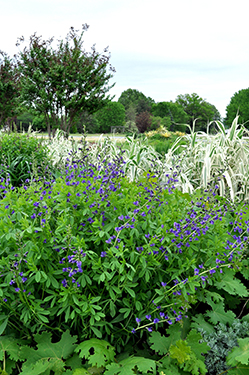| |
UT Gardens April 2017 Plant of the Month: Baptisia
By Justin Stefanski, UT Extension Central Region Office
| |

Blue false indigo gets this name from early settlers who used this plant as a substitute for true indigo, which is of the genus Indigofera, for making blue dyes. Photo of specimen in the UT Gardens, Jackson, by C. Reese, courtesy UTIA.
|
Spring sunshine is slowly waking gardens across Tennessee from their winter slumber, and while many of our favorite herbaceous perennials are still several months away from hitting their stride, one plant is a delightful exception. This early blooming pleaser is Baptisia australis, commonly referred to as blue false indigo.
Blue false indigo gets this name from early settlers who used this plant as a substitute for true indigo, which is of the genus Indigofera, for making blue dyes. Other baptisia species occur in Tennessee, including Baptisia alba known as white wild indigo, Baptisia albascens known as spike wild indigo and Baptisia tinctoria known as horsefly weed.
Blue false indigo is the most well known of the baptisia species that grow in Tennessee. This seemingly delicate perennial is actually a sturdy native plant that can be seen growing in open wooded areas and along stream banks in the Central Basin and in isolated populations on the Cumberland Plateau and Highland Rim. It usually reaches a height of 3 to 4 feet, is clump forming and can become shrubby in appearance when fully grown. Its leaves are slightly pale green in color and grow in clusters of three small leaflets. It is easily found at garden centers.
Baptisia flowers closely resemble the flowers of other plants in pea family and are a pale blue to purple. They grow in spikes that can be anywhere from 5 to 15 inches in length. In Tennessee, blooms will start showing in late April and will persist through the month of May and occasionally into early June. Baptisia attracts a wide array of pollinating insects looking for an early season nectary snack. It is a particular favorite of bumble bees. After it has finished blooming, an abundance of attractive brownish, bean-like seed clusters will form, giving the plant a unique and attractive appearance for the remainder of the growing season. In the fall, the foliage will turn yellow and then grayish silver, before dying back to the ground after a heavy frost.
Baptisia prefers a sunny to part shade location and likes moist, but well-drained, soil. Baptisia australis can be planted in heavy clay soils and can tolerate a fair amount of moisture, making it a suitable plant choice for use in rain gardens. At the UT Gardens, Knoxville, baptisia has survived several years in conditions that range from extended swamp to long droughts.
Most baptisia species are excellent sustainable plant choices and are relatively insect and disease free. Occasionally, false wild indigo will require some degree of staking and support due to the shrubby growth form, and when seed pods become abundant it can cause the plant stems to droop. When looking for baptisia at your local garden center, the Decadence® series from Proven Winners is among the many choices available.
Look for this baptisia at any of the UT Garden locations across the state of Tennessee and consider giving this early blooming perennial a spot in your garden!
The UT Gardens includes plant collections located in Knoxville, Jackson and Crossville. Designated as the official botanical garden for the State of Tennessee, the collections are part of the UT Institute of Agriculture. The Gardens’ mission is to foster appreciation, education and stewardship of plants through garden displays, educational programs and research trials. The Gardens are open during all seasons and free to the public. For more information, see the Gardens website: ag.tennessee.edu/utg.
Published April 11, 2017 |

